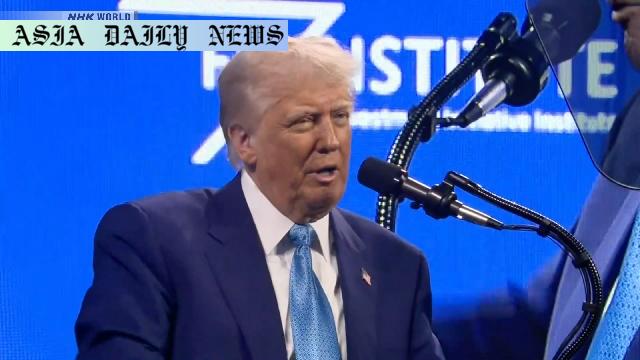Trump’s Strategy: In just one month, Donald Trump has signed executive orders at a record pace, shocking many with his actions.

Understanding “Flood the Zone” Strategy
Donald Trump’s first month back in the White House has been nothing short of action-packed. With a flurry of executive orders and bold initiatives, he has demonstrated a high-paced approach that has not only grabbed public attention but also set the media abuzz. At the heart of this chaotic dynamism lies the “flood the zone” strategy, a communication tactic designed to dominate the news cycle by overwhelming it with constant events and information.
This strategy effectively prevents critics, including the media, from focusing on one particular issue. By rapidly rolling out initiatives, the administration shifts attention from controversies as quickly as they arise while sustaining a narrative of unmatched productivity. This approach isn’t new; it was a distinguishing characteristic of his first term, championed by his former chief strategist, Steve Bannon.
The Flurry of Executive Actions
Within just four weeks of resuming office, Trump has initiated a series of polarizing decisions. These include notable actions like withdrawing from the Paris Agreement and imposing tariffs, both of which reinforce his “America First” campaign ethos. By doing so, Trump directly addressed longstanding goals that resonate with his core voter base while inviting criticism from environmental advocates and global trade partners.
Trump proudly declared, “We’ve accomplished more in four weeks than most administrations accomplish in four years.” While this statement exemplifies his unfiltered public persona, experts debate the long-term effectiveness of his rapid administrative decisions. The current momentum, though striking, may face sustainability challenges as systemic consequences emerge.
Communication Channels: A Multipronged Approach
One striking feature of Trump’s strategy is his use of varied communication channels. From daily posts on social media platforms to impromptu interviews aboard Air Force One, Trump ensures his messages reach a broad audience. This diversity in outreach amplifies his voice while further crowding the media space. Press conferences remain another powerful medium, often marked by notable soundbites that receive prolonged coverage.
However, the unpredictability of his comments also creates complications for traditional media outlets, forcing them to focus on reactive rather than intentional reporting. By keeping the public and critics unsure of his next steps, Trump solidifies his role as an unpredictable force in American politics.
Approval Ratings and Public Perception
Despite the controversies surrounding his decisions, Trump’s approval ratings remain steady at 45%, the same as shortly after his inauguration. This indicates firm support among his base, likely buoyed by his commitment to campaign promises. However, experts like Professor Maeshima Kazuhiro caution against overestimating the sustainability of such momentum.
The professor predicts that Trump’s high-energy governance may diminish after two months as the novelty wears thin and practical challenges emerge. While his prolific early actions make headlines, debates about their efficacy and fallout will likely dominate future narratives.
Challenges Going Forward
Looking ahead, the Trump administration faces significant hurdles. The global backlash from leaving the Paris Agreement may strain international relations further, while tariff policies risk igniting economic tensions. Domestically, opposition parties are already mobilizing to counteract his rapid agenda.
The “flood the zone” strategy may create short-term gains, but the long-term effects on governance will depend on the administration’s ability to manage dissent, implement policies effectively, and sustain public support. Trump’s leadership style seeks to create shockwaves, but whether these actions translate to meaningful reform remains uncertain.
Conclusion
President Donald Trump’s return to office marks a distinctive chapter in American politics. His reliance on the “flood the zone” tactic underscores a desire to stay not just relevant but dominant in the world’s most volatile news cycles. Whether this aggressive strategy will yield tangible policy success or face inevitable backlash as time progresses is yet to be determined. For now, Trump’s audacious approach serves as a masterclass in controlling public narrative through sheer volume and tenacity.
Commentary
The Effectiveness of “Flood the Zone”
The “flood the zone” strategy employed by President Trump is undeniably a bold and audacious move. On one hand, it has proven highly effective in captivating media attention and maintaining momentum for his administration’s activities. By launching numerous initiatives in a short span of time, his strategy forces both supporters and critics to keep pace, creating a sense of action-packed governance. It brings to light the challenges faced by traditional media in adapting to unconventional tactics.
Short-Term Gains Versus Long-Term Viability
However, as effective as this strategy might seem in the short term, its long-term viability remains questionable. Rapid policymaking, particularly on contentious topics like tariffs and environmental policies, carries the risk of unforeseen consequences that could outweigh initial advantages. Additionally, public and political fatigue could set in, making it harder to maintain the same level of engagement or support over time.
A Message to the Public
The key takeaway is this: the strategy of overwhelming communication and action may keep critics uncoordinated, but it also demands a critically discerning audience. Citizens must remain vigilant and strive to sift through the information overload to reach substantive discussions. Only time will tell if Trump’s high-energy approach will stand the test of effectiveness or if it is yet another fleeting political experiment.


